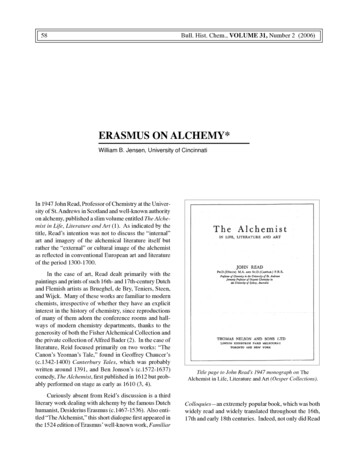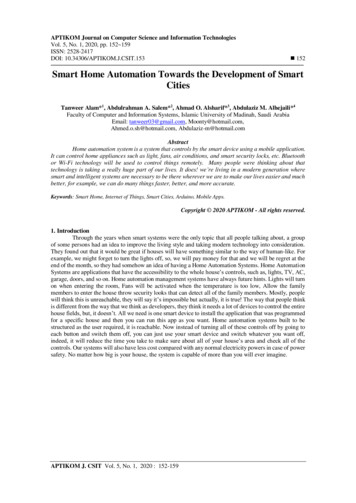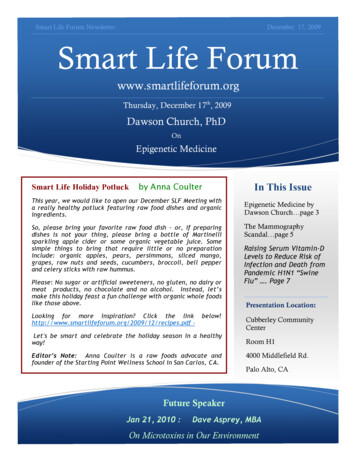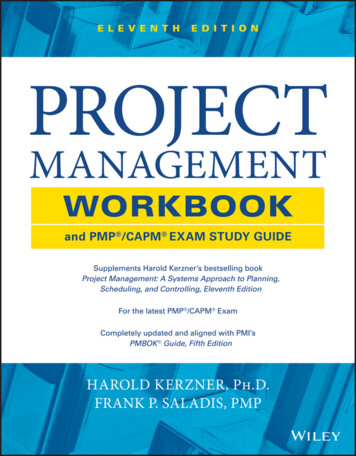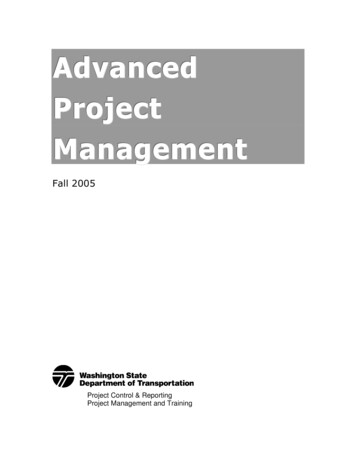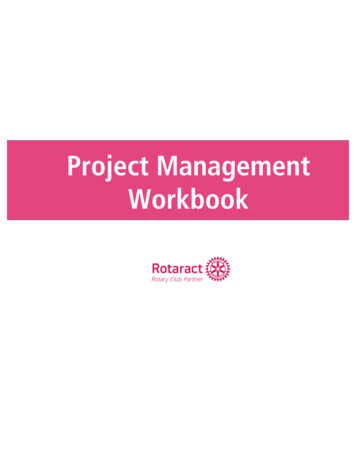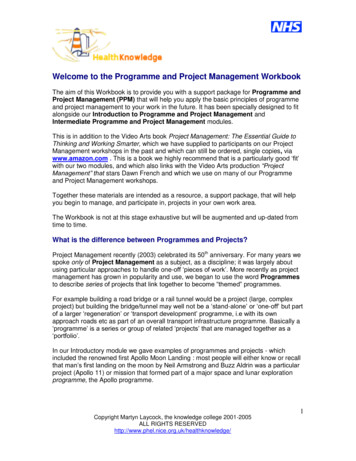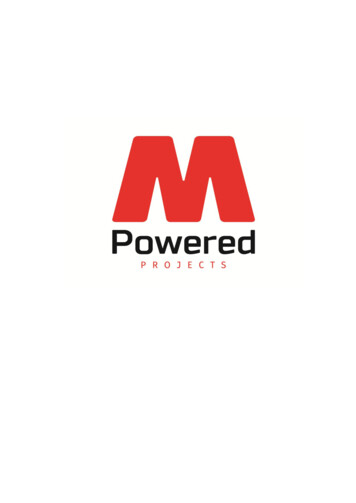
Transcription
PROJECTMANAGEMENTWORKBOOKISUCCESSFUL TEAM SUCCESSFUL PROJECTCOMMUNICATION, TEAM BUILDINGAND CONFLICT MANAGEMENTIN PROJECTS
Project Management Workbook IBy Marzena Wieczorek & Katarzyna PiecuchProofreading: Emma MurtaghEdition: IIBrzesko & Galway 2019Copyright 2019 M-Powered Projects LimitedAll Rights Reserved, M-Powered Projects Limited
Dear Reader,When I first started participating in projects, I did not know the first thing about projectmanagement. I was a political science graduate who was lucky to get on the Europeantrain.It took me years to learn from the successes and failures of my colleagues. WhenI finally started managing my own projects, I obsessed about becoming the mosteffective and successful project manager possible. I read books, attended courses, andparticipated in conferences. I adapted and tested a vast number of processes. I alsocreated my own project management tools.You now have in your hands the culmination of my project management studies andpractices.Many professionals working in the non-profit or education sectors, or for small andmedium size enterprises (SMEs), are reluctant to engage in project managementprocesses. There is often a fear that these processes will be tedious, full of jargon,or inapplicable to the needs of their organisation.The aim of this workbook is to demystify project management processes anddemonstrate how they can be applied successfully to organisations like yours. With theright investment of time and effort, this workbook will help you to build your competencyin project management, bringing more satisfaction, enjoyment, and success to both youpersonally and your organisation.I hope you enjoy this journey!Marzena WieczorekProject Management Professional Founder Director of M-Powered Projects Ltd.
Table of content1.Introduction .92.Introduction to Project Management . 112.1Projects, programmes, and portfolios . 112.2Project lifecycle . 172.3Project timeline . 232.4Work breakdown structure and budget . 262.5Constraints . 272.6Project manager . 293.Project Management Handbook and map . 304.Empowered project team . 335.6.4.1Organisational structure . 334.2Teams in international projects . 354.3Steering committee . 364.4Project team management tools . 394.5Acquiring a project team . 404.6Meetings . 404.7Team development . 444.8Motivation and management styles . 47Communication. 515.1Communication plan . 515.2Giving feedback . 535.3Rapport . 545.4Who has a problem? . 555.5Conflict management . 57Work-life balance. The key to empowering your team and projects . 606.1Your own work-life balance . 616.2Balance your individual energies . 616.2.1Balance your time . 706.2.2A work-life balance plan for your team . 74APPENDIX IProject Management Handbook . 77APPENDIX IITemplates of Project Documents . 87
1. IntroductionThe workbookThe workbook is designed is such a way that you can use it independently. However, itwill be much more enjoyable and productive if you carry out these exercises with yourproject team and use them to stimulate discussion about project management standardsin your organisation and project consortium.You will learn and practise how to: Build and manage your project team,Ensure and enjoy effective communication,Create a conflict resolution strategy,Develop your unique project management handbook.What these materials are notThese materials are not an exhaustive compilation of all the project managementknowledge and processes available today. Rather, they are a selection of useful toolsthat we would like to introduce you to, and encourage you to test and implement in yourwork. The goal is to present a number of different project management instruments sothat you can choose the ones most suitable to you and your projects, based on yourown style and preferences, but also the scope and type of projects in which you areinvolved.If you are looking for comprehensive, generic project management guidelines, or if youare interested in accruing professional certification, then we would recommend you getin touch with organisations like the Project Management Institute (www.pmi.org).These materials are also not intended to serve as guidelines to the reporting proceduresof EU projects. Reporting requirements vary from programme to programme and it isimportant to inform yourself about the requirements for your project and meet themaccordingly.Who should use themThe workbook is designed for people and organisations involved in projects. Theworkbook is for: Project managers, coordinators, professionals involved in projects, Decision makers in organisations, such as senior managers and directors whowish to improve project management processes,9
Experienced project managers who want to improve their management skills andlearn about new tools and techniques, Inexperienced professionals who wish to learn how to manage internationalprojects.How to use these materialsThe workbook has five main chapters: Introduction to Project ManagementProject Management Handbook & MapEmpowered Project TeamCommunicationsWork Life Balance in a Project TeamThe chapters contain theory, case studies, and exercises.At the end of the workbook, you will also find: 10Project management handbook worksheets, which will help you to create yourown handbook (Appendix I),Templates for useful project documents, such as a meeting agendas and minutes(Appendix II).
2. Introduction to Project Management2.1 Projects, programmes, and portfoliosA project is a temporary undertaking to create a unique product, service, or result1.Projects are critical for the change and development of many organisations, but they aredifferent from everyday operational work, and are often more challenging to manage.A programme is a group of related projects that are being managed in a coordinatedway to reach goals, which would not be accessible through managing these projectsindividually.A portfolio refers to programmes and projects managed by an organisation to achievestrategic goals.From my experience, not many organisations involved in projects use the projectprogramme-portfolio structure or ―tree‖. There is, however, an advantage in applyingthis structure in your organisation: it helps to decide which projects the organisationshould get involved in to achieve its strategic goals. With this approach, eachprogramme refers to a specific strategic goal of the organisation.A simple project-programme-portfolio tree may look as PROJECT1A Guide to the Project Management Body of Knowledge (PMBOK Guide) (5th ed.) (2013) ProjectManagement Institute11
A more complex project-programme-portfolio tree could include a single project thatspans more than one programme. Such structures vary in organisations. However, thekey point is to understand why we take on projects and how they fit into the strategicgoals of our organisation.Exercise No. 1This exercise will help you to build your organisation‘s project-programme-portfolio tree.The goal of this exercise is to help you to put a framework on the various projects inwhich your organisation is involved and understand how the projects meet your strategicobjectives.You can do this exercise on your own or with your team.You will need: card in three colours: project cards, programmes cards, and a portfolio card.Alternatively, you can use the templates provided in the following pages;a blank piece of a flipchart paper;glue;a crayon or a marker.Your first task is to think about the main strategic goal or goals of your organisation.Does it want to change the primary school education system in your country, or improvethe wellbeing of seniors in your city? Try to be specific. Write the goal or goals ona portfolio card and paste it at the top of a blank piece of paper.Now, on the separate project cards, list all the projects your organisation is involved in(or at least the projects you are aware of). Describe them briefly.Have a closer look at the project cards you have filled out. Is there a pattern there? Canyou group them? Do they belong to different programmes? Take the programmes cardsand title them accordingly. Paste them under the portfolio card and group the projectson the page according to the programme to which they belong.Some projects may not belong to programmes or there may be some overlap. Takea crayon or a marker and draw lines between the portfolio, programmes, and projects,indicating any links that exist between them.If you do this exercise with a team, discuss your project-programme-portfolio tree witheach other. Which projects and programmes are the most important for yourorganisation, your colleagues, and you, personally? Is there anything missing in your oryour colleagues‘ trees? Should your organisation get involved in different projects toachieve its strategic goals?12
PROJECT:nameDESCRIPTION(one sentence):PROJECT:nameDESCRIPTION(one sentence):PROJECT:nameDESCRIPTION(one sentence):PROJECT:nameDESCRIPTION(one sentence):13
PROJECT:nameDESCRIPTION(one sentence):PROJECT:nameDESCRIPTION(one sentence):PROJECT:nameDESCRIPTION(one sentence):PROJECT:nameDESCRIPTION(one sentence):14
PROGRAMME:nameOBJECTIVE OF THE PROGRAMME(one sentence):PROGRAMME:nameOBJECTIVE OF THE PROGRAMME(one sentence):PROGRAMME:nameOBJECTIVE OF THE PROGRAMME(one sentence):PROGRAMME:nameOBJECTIVE OF THE PROGRAMME(one sentence):15
PORTFOLIO:nameSTRATEGIC GOAL(S) OF THE ORGANISATION:16
2.2 Project lifecycleThere are different types of projects. Some of them last a couple of months, others goon for many years. However, all of them have a similar lifecycle.The following graph depicts a project lifecycle that is typical for European projects, butcan apply to many others:17
Exercise No. 2What do you think the project manager‘s tasks are at each project lifecycle stage?Write them down:Preparation of a project proposal:Preparation of a project management handbook:Project implementation:18
Preparation of final reports and lessons learnedProject managers often overlook the preparation phase, which follows project approval.They believe that a project application, which usually contains dozens, if not hundreds,of pages, will be a sufficient reference tool for the project team and the importantstakeholders involved. This is a mistake.Let us think about the thick, unfriendly, and bureaucratic documents that are submittedto attain grants or sponsors‘ approval. How easy are they to read? Bear in mind that ifyou are planning an international project, most team members will not be nativespeakers of the project application language. How accessible are these documents to allinvolved?The truth is that these documents are usually quite laborious to read, and there is littlechance that your project team will analyse them carefully. Moreover, these applicationstend to have just one brief section dedicated to project management processes.Therefore, it is important that you, as a project manager, adapt the project applicationinto a more friendly, accessible and practical document, which we at M-Powered calla project management handbook. This handbook should describe project objectives,duration, resources, partner organisations, timeline, and activities, as well as plans forhuman resources, communications, stakeholders, quality, risk, and change management.In this workbook, you will find many tools and ideas that will help you to write your ownproject management handbook. At the end of the workbook, you will also find handbookworksheets.In the next sections you will find four checklists. They will help you to ensure that allnecessary tasks are completed at every
Introduction to Project Management Project Management Handbook & Map Empowered Project Team Communications Work Life Balance in a Project Team The chapters contain theory, case studies, and exercises. At the end of the workbook, you will also find: Project management handbook worksheets, which will help you to create your own handbook (Appendix I),
